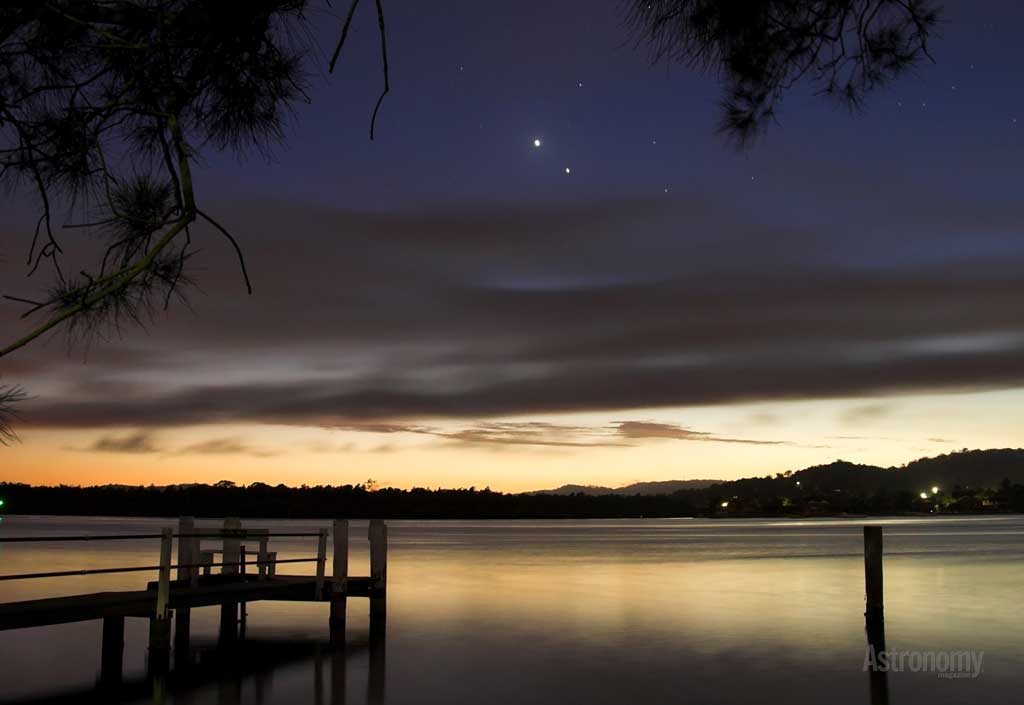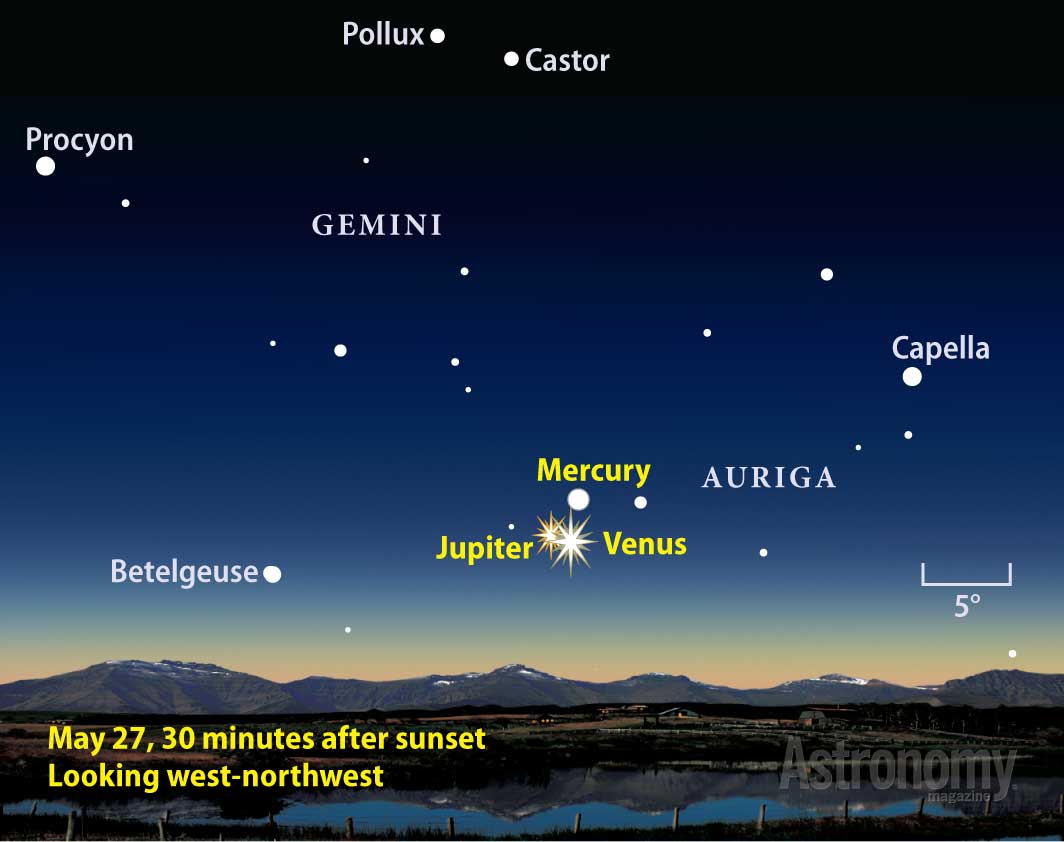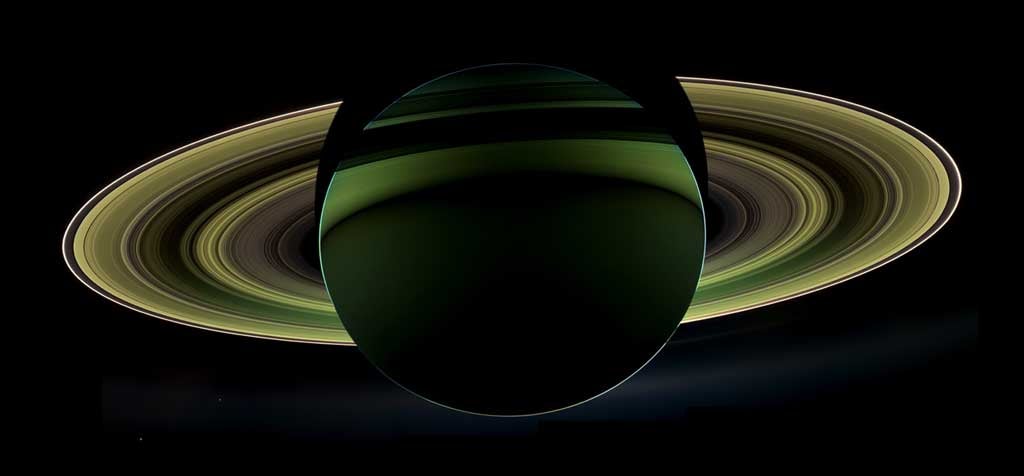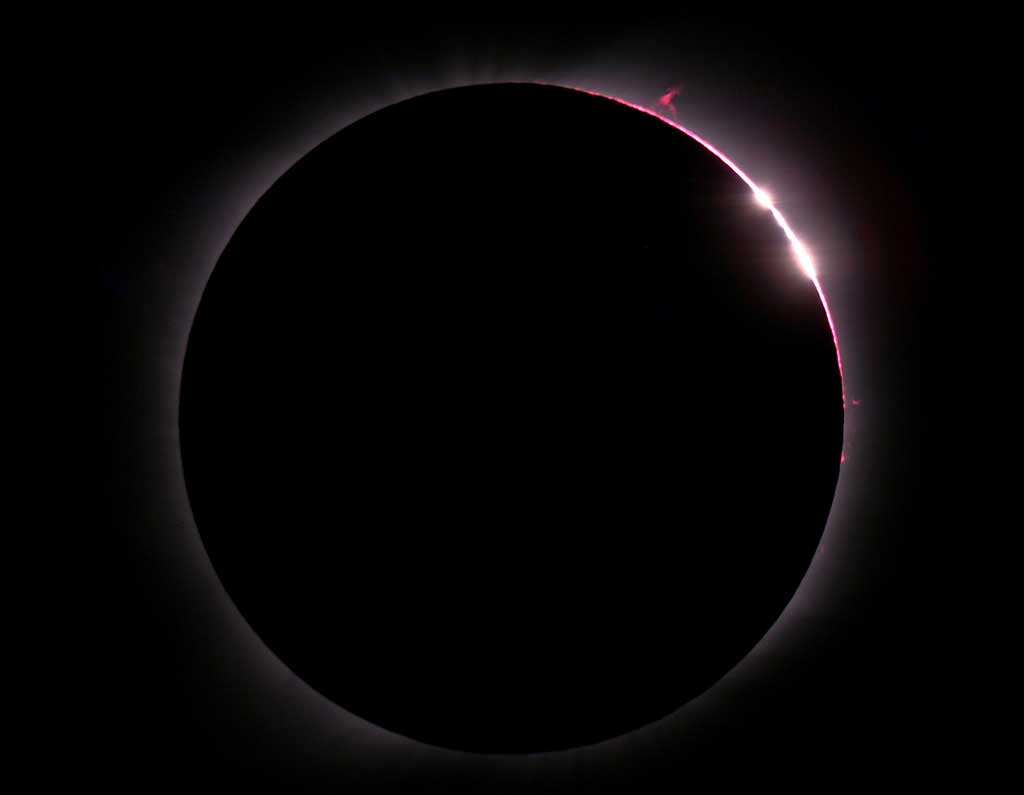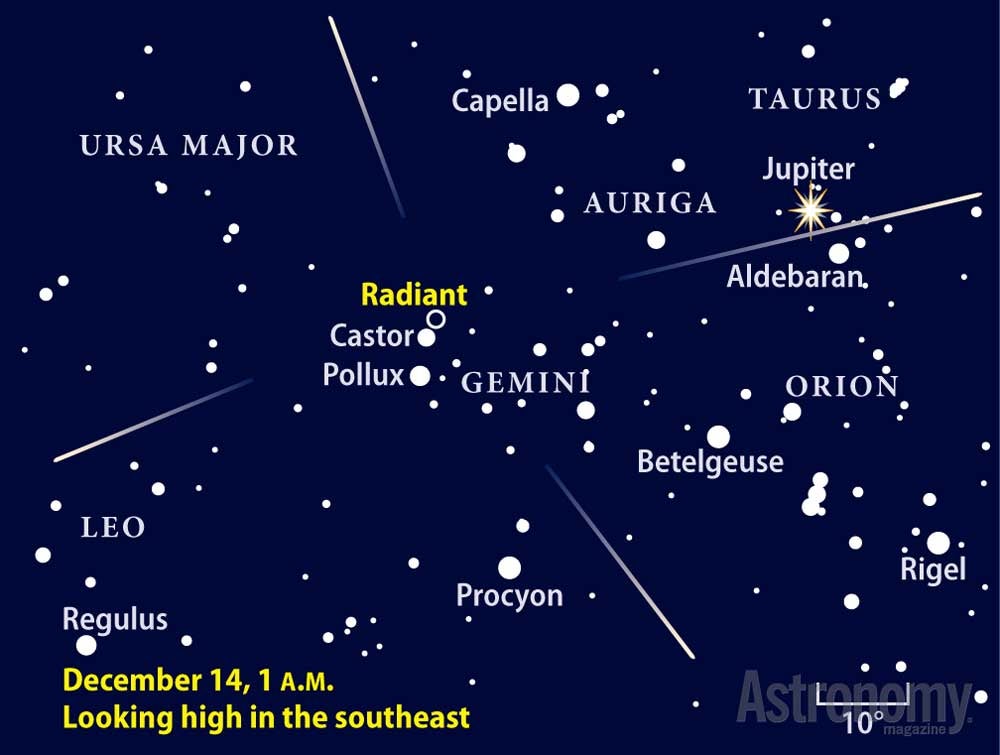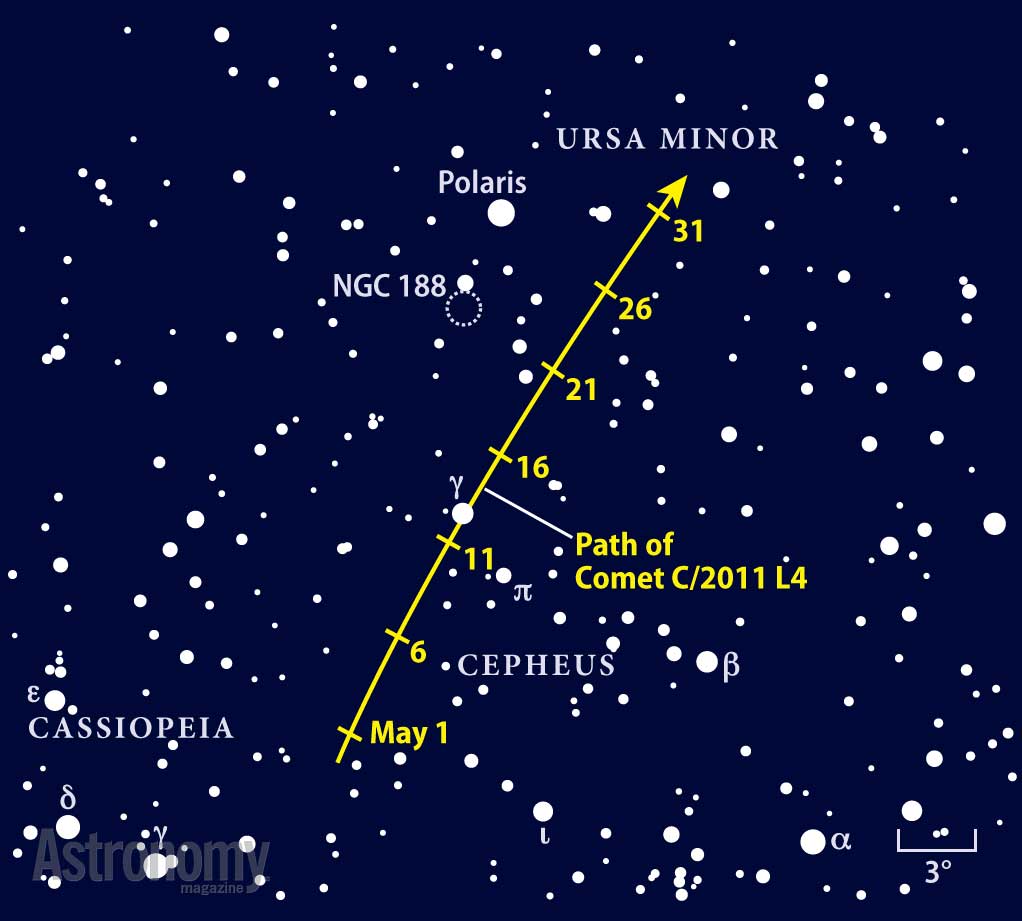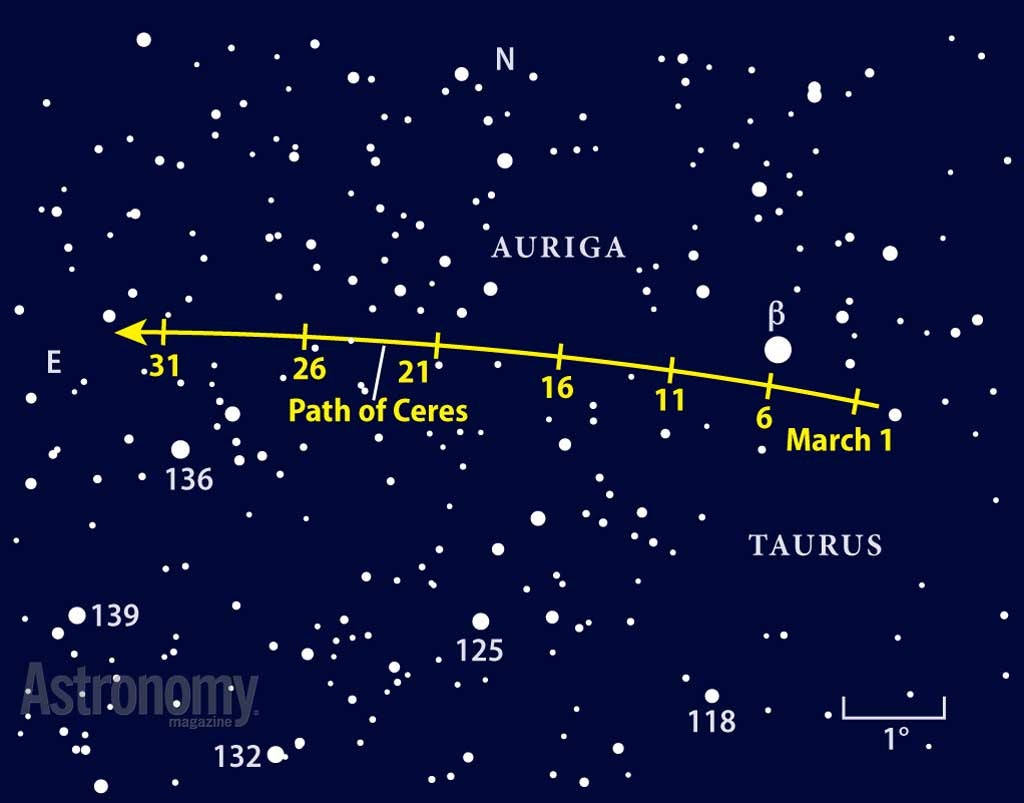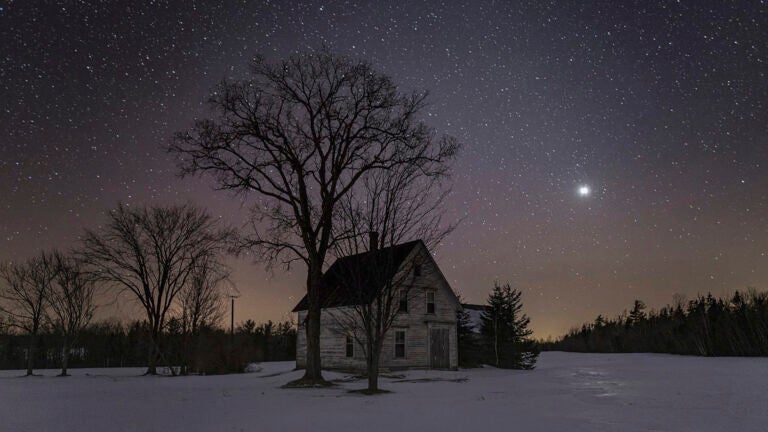The early morning hours offer the return of Uranus and Neptune. You’ll need binoculars or a telescope to find these distant worlds, which were lost in the Sun’s glare for much of the winter and spring.
Three planets adorn late May’s evening sky. We’ll begin with the brightest, Venus, which is emerging in the west-northwest after its late March superior conjunction. Watch for the magnitude –3.9 planet just above the horizon starting in May’s second week. Although it stands only a few degrees high 30 minutes after sunset, its visibility improves in the following weeks.
You might be able to spot the crescent Moon on May 10, when our satellite slides 2° to the planet’s lower left. The two appear 4° high a half-hour after sunset from mid-northern latitudes. You’ll need binoculars to find the Moon, which is only 1 percent lit.
Jupiter then lies to the pair’s upper left and nearly 20° high. A much thicker crescent Moon greets this planet two days later. Venus climbs to meet Jupiter in late May, but not before Mercury joins the show. The innermost planet comes into view after midmonth and passes 1.4° due north (upper right) of its sister world May 24. Mercury then glows at magnitude –0.9, three full magnitudes fainter than Venus. Jupiter, which shines at magnitude –1.9, lies a mere 4° to Venus’ upper left.
Following this series of conjunctions, Venus and Mercury continue to climb higher in the evening sky while Jupiter slides deeper into twilight. Mercury will reach its greatest elongation from the Sun on June 12, when it lies 24° east of our star and 4° from Venus.
When viewed through a telescope during May, Mercury and Venus appear distinctly different. Venus spans 10″ and shows a nearly full phase, waning to 96 percent lit on the 31st. The illuminated portion of Mercury’s 6″-diameter disk shrinks from 80 percent to 65 percent in the week following its May 24 conjunction with Venus.
Jupiter’s low altitude hampers its telescopic appearance. Your best views will come in early May, when the gas giant spans 34″ and should show some detail starting an hour or so after sunset. The planet’s four bright moons remain easy to see all month.
Although Saturn reached opposition and peak visibility in late April, the view hardly deteriorates during May. Even better, the ringed planet stands higher in the evening sky and thus makes a more tempting target. At midmonth, it lies nearly 30° high in the southeast an hour after the Sun goes down and remains on view until morning twilight commences.
When viewed through a telescope, the ringed world certainly lives up to its nickname. At first glance, it’s easy to overlook the planet itself. But take a few minutes to examine the globe, which measures 19″ across the equator and 17″ through the poles. This flattening is easy to see once you know to look for it.
Next, shift your gaze to the rings. They span 43″ and tilt 18° to our line of sight in mid-May — a gorgeous scene through any telescope. Even under mediocre observing conditions, you should see the broad Cassini Division that separates the planet’s two brightest rings.
Several saturnian moons also show up through small telescopes. The brightest is Titan, the second-largest moon in the solar system, which glows at 8th magnitude and orbits Saturn in 16 days. You can find it north of Saturn on May 14/15 and 30/31, and south of the planet May 6/7 and 22/23.
Take notice May 22/23, when 10th-magnitude Rhea and 12th-magnitude Enceladus join Titan in a straight line south of the planet. Two other 10th-magnitude moons, Tethys and Dione, show up north and east of Saturn, respectively. The alignment will be worth viewing even though Earth’s Moon shines brightly only 5° from Saturn.
By late May, both Neptune and Uranus rise well before twilight paints the predawn sky. Neptune pokes above the horizon by 2 a.m. local daylight time on the 31st, surrounded by the stars of Aquarius. That morning, the most distant major planet appears 6° south of the Last Quarter Moon. The 8th-magnitude world lies in the same binocular field as 5th-magnitude Sigma (σ) Aquarii.
Uranus rises around 3 a.m. local daylight time against the backdrop of Pisces. Late May is the best time to search for this 6th-magnitude world, which appears some 10° above the eastern horizon as twilight begins. Its low altitude and dimness will make it a challenge to see unless you have a clear, dark sky. The planet lies 4° south-southwest of the 4th-magnitude star Delta (δ) Piscium.
The May 9/10 New Moon passes directly in front of the Sun for residents along a path that stretches across northern Australia, Papua New Guinea, the Solomon Islands, and the Pacific Ocean. Because the Moon is near the far point in its orbit around Earth, this geometry creates an annular solar eclipse, and viewers will see a ring of sunlight around the Moon. (Be sure to view with a safe solar filter.) Observers on the center line in Queensland, Australia, will witness more than four minutes of annularity.
People in Hawaii will experience a partial eclipse of the Sun. Those on the southern coast of the Big Island will see 50 percent of the Sun blocked at 3:52 p.m. HST May 9. Honolulu residents will find 44 percent of the Sun covered at 3:48 p.m. HST.
An essentially undetectable penumbral lunar eclipse occurs May 24/25, when 1.6 percent of the Full Moon dips into the fringe of Earth’s outer shadow. The eclipse begins at 11:53 p.m. EDT and lasts 34 minutes.
The most famous lunar valley is the Alpine Valley in the far north. But this month, let’s focus on a worthy challenger: the Rheita Valley in the Moon’s southeastern quadrant. Interestingly, the two valleys formed differently. The Alpine developed when the lunar crust pulled apart and the land between collapsed. The Rheita comprises a line of overlapping craters. The series of impactors that created it fell in rapid succession, which obliterated the central peak and rim of the crater formed just before it.
Such crater chains are common around most large young impact features, such as the crater Copernicus. The chains point radially away from the impact’s center because the excavated material shot out in linear sprays. The Rheita Valley is the widest such chain, which implies that the original impact must have been huge. It was: It formed Mare Nectaris to the north.
With a bit of practice and an eye for detail, you can tell that the Rheita Valley is neither the freshest nor the oldest feature on this part of the Moon. Note a couple of chopped-off circles on the valley’s northeastern flank. Their worn-down rims and floors testify to their creation prior to the valley. Rheita Crater at the valley’s northeastern edge and Young D at the south end obviously arrived later because they appear sharper and have reshaped part of the valley.
Sunrise over Rheita Valley occurs May 13, but the view on the 14th more closely matches the image above. Take another look May 26 and 27, when the lighting is reversed under a setting Sun. This is when you can best see that the valley points directly back to Mare Nectaris.
Catching dust particles from Comet 1P/Halley isn’t as hard as you might think. The European Space Agency’s Giotto spacecraft managed the task during its 1986 encounter. And this month, Earth will sweep up many more during the annual Eta Aquarid meteor shower. These particles lie nowhere near Halley, which currently resides in the outer solar system, but instead fill the comet’s orbit.
The shower peaks the night of May 5/6, when Earth runs into the densest part of this debris stream. The meteors appear to radiate from a point in Aquarius that rises shortly before 3 a.m. local daylight time. This offers an hour or two of observing before twilight starts to interfere. Fortunately, the Moon doesn’t rise until around 4 a.m. For residents at mid-northern latitudes, the low radiant reduces the meteor count to about one-third the maximum rate of 55 meteors per hour.
| WHEN TO VIEW THE PLANETS |
||
| Evening Sky |
Midnight | Morning Sky |
| Mercury (northwest) | Saturn (south) | Saturn (west) |
| Venus (northwest) | Uranus (east) | |
| Jupiter (west) | Neptune (southeast) | |
| Saturn (southeast) | ||
The comet that charmed us in March and April remains within easy reach until mid-May as it fades on its outbound journey to the distant Oort Cloud. C/2011 L4 (PANSTARRS) should be easy to spot through binoculars from a dark site or with a small telescope from the suburbs. By summertime, however, you’ll need bigger scopes and a dark sky to track its retreat. Fortunately, the comet slides through the Little Dipper in Ursa Minor this month, which means it stays visible all night for Northern Hemisphere observers.
The easiest way to follow its 7th-magnitude glow is to jump from 3rd-magnitude Gamma (γ) Cephei, known to many stargazers as the “top of the house” in the crude outline of Cepheus. It is the only bright star between Cassiopeia and Polaris. You won’t have to move at all May 12 and 13 because PANSTARRS lies in the same field as Gamma.
Start observing the comet at low power to gauge the tail’s extent. Gently tap the scope to allow your motion-sensitive night vision to pick up the low-contrast streak. Boost the magnification past 100x to examine the structure closely. The bright head, or coma, appears sharper on its southern edge where solar radiation pushes back on recently released dust. The coma likely will be brightest in the middle at the “false nucleus,” the dense dust shroud that hides the true surface from sight.
On the nights of May 27 and 28, PANSTARRS tilts edge-on to our line of sight. Think of a flashlight’s narrow beam seen from the side. Look for the comet before the waning gibbous Moon rises shortly before midnight. PANSTARRS then appears just a few degrees from Polaris and the modest star cluster NGC 188. Astronomers consider this open cluster to be one of the oldest in the galaxy.
If you want to locate the king of the asteroid belt quickly, wait until the end of May. By then, 1 Ceres has exited the Milky Way’s dense star fields and passes through a field of bright guide stars near 1st-magnitude Pollux. The simplest way to find it is to locate 4th-magnitude Iota (ι) Geminorum and then nudge your scope to the spot shown on the chart below for the particular night. The pattern of plotted stars should be recognizable through the eyepiece, with the odd man out being the 9th-magnitude asteroid.
If you need an asteroid fix early this month, you must accept a challenge. The rich starry background of our galaxy in western Gemini is like an orchard where every tree looks pretty much alike. There are precious few stars that stand out. Even if you use a go-to scope, the chances are you will face three or four stars of similar brightness. Make a quick sketch and return the next night to see which dot moved.
Sometimes there’s another way to tell the difference between Ceres and a star of similar brightness. Stars twinkle in turbulent air, but planets do not (in short because they appear to cover more sky). Asteroids experience this non-twinkling effect, too, but more subtly. Experienced observers also note that larger asteroids such as Ceres appear flat compared with the sharper stars. Pump up the magnification and give it a try.
Martin Ratcliffe provides planetarium development for Sky-Skan, Inc. from his home in Wichita, Kansas. Meteorologist Alister Ling works for Environment Canada in Edmonton, Alberta.

